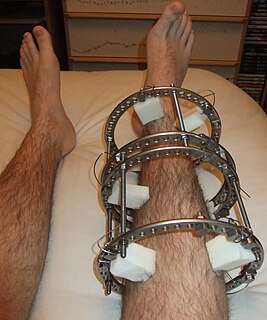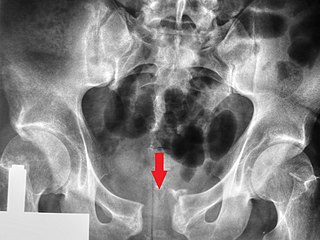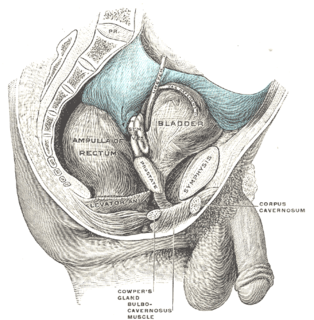Related Research Articles
The human skeleton is the internal framework of the human body. It is composed of around 270 bones at birth – this total decreases to around 206 bones by adulthood after some bones get fused together. The bone mass in the skeleton reaches maximum density around age 21. The human skeleton can be divided into the axial skeleton and the appendicular skeleton. The axial skeleton is formed by the vertebral column, the rib cage, the skull and other associated bones. The appendicular skeleton, which is attached to the axial skeleton, is formed by the shoulder girdle, the pelvic girdle and the bones of the upper and lower limbs.
A downer is an animal, usually livestock, that cannot stand on its own and therefore is to be killed. A downed animal, one that is unable to stand, is not necessarily a downer.

A nosebleed, also known as epistaxis, is bleeding from the nose. Blood can also flow down into the stomach and cause nausea and vomiting. In more severe cases blood may come out of both nostrils. Rarely bleeding may be so significant low blood pressure occurs. Rarely the blood can come up the nasolacrimal duct and out from the eye.

A bone fracture is a medical condition in which there is a partial or complete break in the continuity of the bone. In more severe cases, the bone may be broken into several pieces. A bone fracture may be the result of high force impact or stress, or a minimal trauma injury as a result of certain medical conditions that weaken the bones, such as osteoporosis, osteopenia, bone cancer, or osteogenesis imperfecta, where the fracture is then properly termed a pathologic fracture.

External fixation is a surgical treatment wherein rods are screwed into bone and exit the body to be attached to a stabilizing structure on the outside of the body. It is an alternative to internal fixation, where the components used to provide stability are positioned entirely within the patient's body. It is used to stabilize bone and soft tissues at a distance from the operative or injury focus. They provide unobstructed access to the relevant skeletal and soft tissue structures for their initial assessment and also for secondary interventions needed to restore bony continuity and a functional soft tissue cover.

Hernia repair refers to a surgical operation for the correction of a hernia—a bulging of internal organs or tissues through the wall that contains it. It can be of two different types: herniorrhaphy; or hernioplasty. This operation may be performed to correct hernias of the abdomen, groin, diaphragm, brain, or at the site of a previous operation. Hernia repair is often performed as an ambulatory procedure.

Blunt trauma, also known as blunt force trauma or non-penetrating trauma, is physical trauma or impactful force to a body part, often occurring with road traffic accidents, direct blows, assaults, injuries during sports, and particularly in the elderly who fall. It is contrasted with penetrating trauma which occurs when an object pierces the skin and enters a tissue of the body, creating an open wound and bruise.

The ischium forms the lower and back part of the hip bone.

A pelvic fracture is a break of the bony structure of the pelvis. This includes any break of the sacrum, hip bones, or tailbone. Symptoms include pain, particularly with movement. Complications may include internal bleeding, injury to the bladder, or vaginal trauma.

Retropubic space is a potential avascular space located between the pubic symphysis and the urinary bladder. The retropubic space is a preperitoneal space, located behind the transversalis fascia and in front of peritoneum.
The extraperitoneal space is the portion of the abdomen and pelvis which does not lie within peritoneum.

Diastasis symphysis pubis is the separation of normally joined pubic bones, as in the dislocation of the bones, without a fracture. Separation of the symphysis pubis can occur spontaneously in at least 1 in 800 vaginal deliveries. It is usually noticed after delivery and has been associated with forceps delivery, rapid second stage of labour or severe abduction of the thighs during delivery. Common signs and symptoms include symphyseal pain aggravated by weight bearing and walking, a waddling gait, pubic tenderness, and a palpable interpubic gap
Cephalo-pelvic disproportion exists when the capacity of the pelvis is inadequate to allow the fetus to negotiate the birth canal. This may be due to a small pelvis, a nongynecoid pelvic formation, a large fetus, an unfavorable orientation of the fetus, or a combination of these factors. Certain medical conditions may distort pelvic bones, such as rickets or a pelvic fracture, and lead to CPD.
Duverney fractures are isolated pelvic fractures involving only the iliac wing. They are caused by direct trauma to the iliac wing, and are generally stable fractures as they do not disrupt the weight bearing pelvic ring.

The hip bone is a large irregular bone, constricted in the center and expanded above and below. In some vertebrates it is composed of three parts: the ilium, ischium, and the pubis.

The pelvis is either the lower part of the trunk of the human body between the abdomen and the thighs or the skeleton embedded in it.
The Young-Burgess classification is a system of categorizing pelvic fractures based on fracture pattern, allowing judgment on the stability of the pelvic ring.
The Tile classification is a system of categorizing pelvic fractures based on fracture pattern, allowing judgment on the stability of the pelvic ring.
A urogenital fistula is an abnormal tract that exists between the urinary tract and bladder, ureters, or urethra. A urogenital fistula can occur between any of the organs and structures of the pelvic region. A fistula allows urine to continually exit through and out the urogenital tract. This can result in significant disability, interference with sexual activity, and other physical health issues, the effects of which may in turn have a negative impact on mental or emotional state, including an increase in social isolation. Urogenital fistulas vary in etiology. Fistulas are usually caused by injury or surgery, but they can also result from malignancy, infection, prolonged and obstructed labor and deliver in childbirth, hysterectomy, radiation therapy or inflammation. Of the fistulas that develop from difficult childbirth, 97 percent occur in developing countries. Congenital urogenital fistulas are rare; only ten cases have been documented. Abnormal passageways can also exist between the vagina and the organs of the gastrointestinal system, and these may also be termed fistulas.

A pelvic binder is a device used to compress the pelvis in those with a pelvic fracture in an effort to stop bleeding. They are specifically recommended for open book pelvic fractures and might not be useful in those with lateral compression fractures.
References
- ↑ Burlew, CC (September 2017). "Preperitoneal pelvic packing for exsanguinating pelvic fractures". International orthopaedics. 41 (9): 1825–1829. doi:10.1007/s00264-017-3485-3. PMID 28447123.
- ↑ ATLS - Advanced Trauma Life Support - Student Course Manual (10 ed.). American College of Surgeons. 2018. pp. 89, 96–97. ISBN 9780996826235.